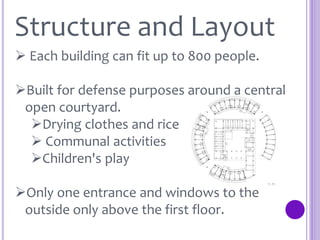Epc presentation 1 slides
- 1. TOPIC 1(A) Traditional dwellings around the world. The Fujian Tulou
- 2. ïBuilt the Neolithic period (6,000 years ago). ïDuring the Western Jin Dynasty (307-12 CE), people from central China began to migrate. ïThe Fujian tulou first built in the Song and Yuan Dynasties (11th-13th centuries) History
- 3. ï Developed from the 14th and 16th centuries (Early and Middle Ming Dynasty) ïThe first tulou ïSmall ïRectangular or square ïPlainly decorated ïWithout stone foundations. ï During Ming Dynasty much larger tulou were constructed.
- 4. Structure and Layout ï Each building can fit up to 800 people. ïBuilt for defense purposes around a central open courtyard. ïDrying clothes and rice ï Communal activities ïChildren's play ïOnly one entrance and windows to the outside only above the first floor.
- 5. Materials ï Outside ïPathways and buildings material ïClay ï250 two- or three-story small uniform rooms ïWooden structures
- 7. RELIGIOUS BUILDING Student Name: Chong Ke Qun 0319214
- 9. Example:
- 12. Structure and Layout Ground floor
- 13. Ornamentation
- 14. Materials
- 15. Interior Design
- 16. Exterior Design
- 17. Use Famous People and the Abbey
- 18. Use Royal and the Abbey
- 19. THANK YOU


















